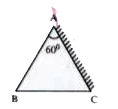In the spectrum of white light by a prism, the colour at the extreme end opposite to the base of prism is :
violet
yellow
red
blue.
The correct Answer is:D
To solve the question, "In the spectrum of white light by a prism, the color at the extreme end opposite to the base of the prism is:", we can follow these steps:
1. Understand the Setup: When white light passes through a prism, it gets dispersed into its constituent colors. This phenomenon is known as dispersion.
2. Identify the Colors in the Spectrum: The colors produced by the dispersion of white light through a prism are arranged in a specific order, which is commonly remembered by the acronym VIBGYOR:
- Violet
- Indigo
- Blue
- Green
- Yellow
- Orange
- Red
3. Determine the Base of the Prism: In a prism, the base is the flat surface. When light enters the prism, it bends and separates into different colors.
4. Locate the Extreme End Opposite to the Base: Since the question asks for the color at the extreme end opposite to the base of the prism, we need to identify which color is at the farthest end of the spectrum from the base.
5. Analyze the Spectrum: In the spectrum produced by the prism:
- The color that is most deviated (bent the most) is violet, which is at one end of the spectrum.
- The color that is least deviated (bent the least) is red, which is at the opposite end of the spectrum.
6. Conclude the Answer: Since the question specifies the color at the extreme end opposite to the base of the prism, we identify that the color at this position is red.
Final Answer:
The color at the extreme end opposite to the base of the prism is red.
---
- Violet
- Indigo
- Blue
- Green
- Yellow
- Orange
- Red
- The color that is most deviated (bent the most) is violet, which is at one end of the spectrum.
- The color that is least deviated (bent the least) is red, which is at the opposite end of the spectrum.
The color at the extreme end opposite to the base of the prism is red.
Topper's Solved these Questions
- SPECTRUMBOOK - ICSECHAPTER - SPECTRUMEXERCISE - EXERCISE A (NUMERICALS)
4 Videos
- SPECTRUMBOOK - ICSECHAPTER - SPECTRUMEXERCISE - EXERCISE B
56 Videos
- SPECTRUMBOOK - ICSECHAPTER - SPECTRUMEXERCISE - EXERCISE A
40 Videos
- SPECIMEN QUESTION PAPERBOOK - ICSECHAPTER - SPECIMEN QUESTION PAPEREXERCISE - QUESTIONS
33 Videos
- WORK,POWER AND ENERGY BOOK - ICSECHAPTER - WORK,POWER AND ENERGY EXERCISE - DIAGRAM BASED MCQ
3 Videos
Similar Questions
Knowledge Check
In refraction of light through a prism the light ray:
Asuffers refraction only at one face of the prismBemergest out from the prism in a direction parallel to the incident rayCbends at both the surface of the prism towards its baseDbends at both the surfaces of the prism opposite to its base.When a white light ray falls on a prism, the ray at its first surface suffers:
AA) no refractionBB) only dispersionCC) only deviationDD) both deviation and dispersion.
The diagram shown below in Fig. 6.8 shows the path taken by a narrow beam of yellow monochromatic light passing through an equiangular glass prism. If the yellow light is replaced by a narrow beam of white light incident at the same angle, draw another diagram to show the passage of white light through the prism and label it to show the effect of the prism on the white light.

View SolutionOn face AC of an equilateraal prism ABC is silvered as shown in fig. The angle of incidence of a light ray inorder that it eventually leaves the prism in the opposite direction from base of prism is n×15∘ where n is (μ=√2)

View SolutionName the colour of white light which is deviated (i) the most, and (ii) the least, on passing through a prism.
View SolutionThe difference between angle of minimum deviation of violet and red rays in the spectrum of white light from a prism is 2∘. If angle of minimum deviation of mean ray is 48∘, the dispersive power of material of the prism is
View SolutionA ray of light is incident on the hypotenuse of a right-angled prism after travelling parallel to the base inside the prism. If μ is the refractive index of the material of the prism, the maximum value of the base angle for which light is totally reflected from the hypotenuse is
View SolutionName the extreme colours in pure spectrum of light.
View Solution
